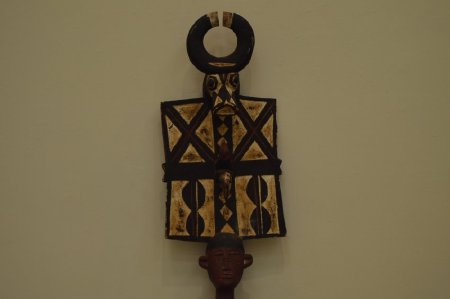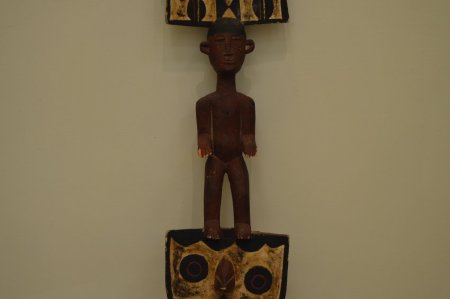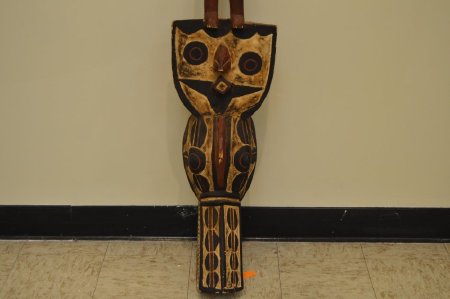Title:
Bwa Style Plank Mask
Object Name:
Mask, Plank, Dance
Other Name:
Mask, Ritual, Anthropomorphic
Place of Origin:
Bwa, Burkina Faso / Mali, Africa
Provenance:
Aboriginal Indigenous Art.
Bwa figures are relatively rare and are associated with divination ceremonies and human and agricultural fertility rites. They are paraded through villages and are offered sacrifices. The Bwa sculpt divination canes with curved ends; diviners use copper or brass bracelets decorated with standing figures that represent the spirits.
The masks of the Bwa represent nature spirits or animals that family elders encountered in the wilderness and which watch over their families. They may represent antelopes, warthogs, wild buffalo, monkeys, crocodiles, serpents, fish, birds, and insects, along with some human beings, and bush spirits who take on supernatural forms. Both the scars on people’s faces and the patterns on the masks represent the moral code or religious laws that the followers of these spirits must obey if they are to receive the blessings of the spirit. A mask has a circular face with geometric designs, and is surmounted by a large plank with a crescent—shaped motif at the upper end. The eyes set off by concentric circles are intended to recall an owl, and the hooked shape extending from its forehead alludes to the hornbill. The motifs are symbols linked to Dwo, the god of the wilderness and to the history of the clan. The mask is worn in front of the face. The dancer looks through the open hole of the mouth. These masks are thought to be inhabited by supernatural forces, who act to benefit the clan, that possess them.
Bwa figures are relatively rare and are associated with divination ceremonies and human and agricultural fertility rites. They are paraded through villages and are offered sacrifices. The Bwa sculpt divination canes with curved ends; diviners use copper or brass bracelets decorated with standing figures that represent the spirits.
The masks of the Bwa represent nature spirits or animals that family elders encountered in the wilderness and which watch over their families. They may represent antelopes, warthogs, wild buffalo, monkeys, crocodiles, serpents, fish, birds, and insects, along with some human beings, and bush spirits who take on supernatural forms. Both the scars on people’s faces and the patterns on the masks represent the moral code or religious laws that the followers of these spirits must obey if they are to receive the blessings of the spirit. A mask has a circular face with geometric designs, and is surmounted by a large plank with a crescent—shaped motif at the upper end. The eyes set off by concentric circles are intended to recall an owl, and the hooked shape extending from its forehead alludes to the hornbill. The motifs are symbols linked to Dwo, the god of the wilderness and to the history of the clan. The mask is worn in front of the face. The dancer looks through the open hole of the mouth. These masks are thought to be inhabited by supernatural forces, who act to benefit the clan, that possess them.
Description:
Long wooden Bwa style plank mask. Circular—shaped horns leading into an animal face, over square—shaped plank, adorned with various black, red and yellow patterns. Human carving in the center of mask, with black hair and rust—colored body. Shield—shaped lower portion, leading into another amimal shape, possibly an alligator or bird. Rust—colored, black and yellow, patina or pigment cover entire surface area.
Collection:
Guy Mace Collection, (Turblex Company)
Material:
Wood W/Paint, Patina or Pigments
Used:
Ritually Used
Technique:
Carving / Painting
Owned:
Art Department, Missouri Southern State University
Accession#:
2015.2.84



